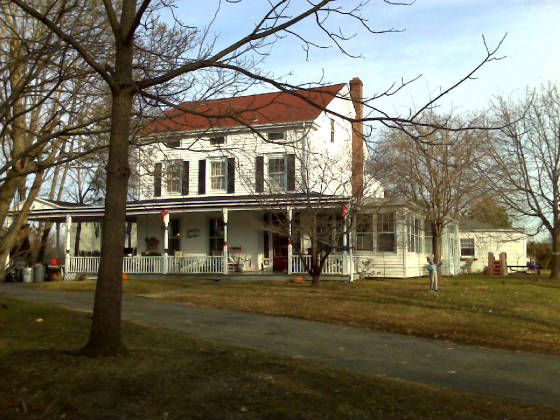|
|
 |
This page gives the history of the house and the site. Here
I publish the results of my research1 (special thanks to Stephen Gale, an Architectural Research Consultant,
who shares a common interest in Freneau and his lands and is helping me research) and my forensic findings of this great Federalist
home.
The history is arranged chronologically with the links below covering the different epochs of the property's
history. A brief timeline and provenance of the property in here:
The story begins with the origin of the
site, which dates back to the earliest settlers of the area in 1686:
|
 |
Then comes the Poet's story- the Freneau's
tenure from 1752 to 1843:
After Freneau, the site began its long and interesting history
as the Magnolia Farm owned by working and gentlemen farmers starting with Tom Ryer in 1843 through Howard C. Higgins
until 1918:
In 1918 the property was sold to the colorful Clarence Ware, a well known horse dealer
and driver from Mount Vernon New York, who brought back the Freneau connection to the property:
Clarence Ware 1918-1947: The Printshop; Citizen Cane; The Radio Show, and FDR.
In 1947 Clarence Ware sold the property to the Fritschs
who continued the connection to the Magnolia Farm by raising champion dogs.
In 1969 Freneau fought his final battle
as a developer tried to raze the site to put up 288 apartments, the community and councilmen rose to its defense as Freneau's
house was put on trial for its life:
In
1973 the house was sold to Victor Armellino (the Mayor of Matawan at the time).
I bought the home in 2004
from the Armellino's and discovered many interesting things about Freneau, the house itself, and its history, which
I published here in detail. Finally in 2021 it was time for us to leave, but not after one more (and my greatest) disscovery.
Philip Comes Home After 200 years, the Chartier's last contribution

|
| The house today |
1 Secondary sources
are Philip M. Marsh who wrote multiple books and articles on Freneau including "Philip Freneau Poet and Journalist"
and a number of articles for the proceedings of the New Jersey Historical Society including "Freneau's Last Home"
in the April, 1939 volume; Lewis Leary who multiple books including"That Rascal freneau- A Study in Literary Failure",
and also contributed articles to the New Jersey Historical Society including Philip Freneau and Monmouth County for the July
1948 volume; Mary Austin's "Philip Freneau- The Poet of the Revolution"; the WPA writers "New Jersey- A
Guide to its Present and Past, 1939; New Aberdeen or the Scotch Settlment of Monmouth County New Jersey, James Steen 1899;
Matawan 1686 - 1936, Written and Illustrated by the Federal Writers Projects, 1939; Documents relating to the Colonial History
of the State of New Jersey, V 21; Evert A Duyckinck and others.
Primary sources include images of the Freneau family
bible, John Hammels notebook at the from the Monmouth County Historical Association Freneau Collection, deeds, newspapers
especially the Red Bank Register, Matawan Journal and New York Times, and other historical documents.
Also
special thanks to Stephen Gale, an Architectural Research Consultant, who shares a common interest in Freneau and his lands
and is helping me research.
|
 |
|
|
 |
|
|
 |
|
|
|
|
|
|
 |

